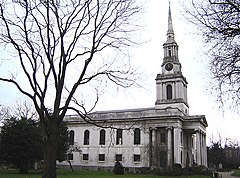Poplar, London
Poplar is an historical, mainly residential area of East London, England, in the London Borough of Tower Hamlets. It is about 5.5 miles (8.9 km) east of Charing Cross. Historically a hamlet in the parish of Stepney, Middlesex, in 1817 Poplar became a civil parish.
In 1855 the Poplar District of the Metropolis was formed, which also included Bromley and Bow. The district became the Metropolitan Borough of Poplar in 1900 which was abolished in 1965. The district centre is Chrisp Street Market. Poplar contains notable examples of public housing including the Lansbury Estate and Balfron Tower.
Architecturally it is a mixture of 18th and 19th-century terraced houses and 20th-century council estates.
St Matthias Old Church is located on Poplar High Street, opposite Tower Hamlets College. It is next to Poplar Town Hall – which has mosaic detail – and Poplar Bowls Club, which is part of Poplar Recreation Ground. A recently reopened sports centre called The Workhouse stands on the site of Poplar Workhouse, where local politician Will Crooks spent some of his earliest years (a nearby council housing estate is named after him).
The Metropolitan Borough of Poplar was the location, in 1921, of the Poplar Rates Rebellion, led by the Mayor, George Lansbury, who was later elected as leader of the Labour Party. As part of the 1951 Festival of Britain, a new council housing estate was built to the north of the East India Dock Road and named the Lansbury Estate after him. This estate includes Chrisp Street Market, which was greatly commended by Lewis Mumford. The same era also saw the construction of the Robin Hood Gardens housing complex (overlooking the northern portal of the Blackwall Tunnel) – designed by architects Peter and Alison Smithson – and the similarly brutalist Balfron Tower, Carradale House and Glenkerry House (to the north) – designed by Ernő Goldfinger. Other notable buildings in Poplar include Poplar Baths, which reopened in 2016 having finally closed in 1988, after the efforts of local campaigners.
...
Wikipedia


